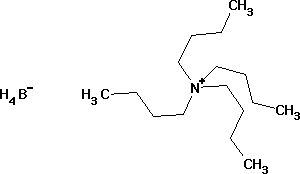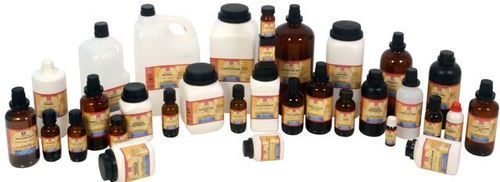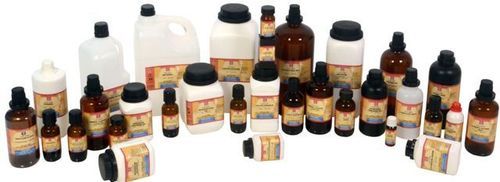Tetra-n-butylammonium borohydride
Product Details:
X
Product Description
LC5198 Tetra-n-butylammonium borohydridefor synthesis
| Order number | Packaging | Quantity | Price |
| AC32198 | Glass bottle | 10 g | 53.10 |
| Product information | |
| Synonyms | Tetra-n-butylammonium-tetrahydridoborate |
| Hill Formula | C16H40BN |
| HS Code | 2942 00 00 |
| EC number | 251-658-2 |
| Molar mass | 257.31 g/mol |
| CAS number | 33725-74-5 |
| Chemical and physical data | |
| Melting point | 124 - 129 C |
| Molar mass | 257.31 g/mol |
| Flash point | 140 C |
| Safety information according to GHS | |
| Hazard Statement(s) | H261: In contact with water releases flammable gases. H314: Causes severe skin burns and eye damage. |
| Precautionary Statement(s) | P280: Wear protective gloves/ protective clothing/ eye protection/ face protection. P301 + P330 + P331: IF SWALLOWED: rinse mouth. Do NOT induce vomiting. P305 + P351 + P338: IF IN EYES: Rinse cautiously with water for several minutes. Remove contact lenses, if present and easy to do. Continue rinsing. P402 + P404: Store in a dry place. Store in a closed container. |
| Signal Word | Danger |
| Hazard Pictogram(s) |
|
| Storage class | 4.3 Materials that form flammble gases in contact with water |
| WGK | WGK 3 highly water endangering |
| Disposal | 26 Alkali and alkaline-earth metals should be taken up in an inert solvent and neutralized by adding 2-propanol (Cat. No. 100995) dropwise with stirring. Should the reaction be more violent than expected, conversion should be carried out with tert-butanol or octanol. Caution: This reaction produces hydrogen, which can form explosive mixtures; take necessary precautions. When the reaction has ceased, add water dropwise; neutralize; container D. In the case of alkali or alkaline-earth borohydrides, add methanol (Cat. No. 106008) with stirring; in the case of alkali or alkaline-earth amides and hydrides, organoaluminium and organotin hydrides, add 2-propanol (Cat. No. 100995) dropwise. The substances, which are usually in solid form, should be previously suspended in an ether! When the respective reaction has ceased, hydrolize with water; then neutralize. Container D or E. Lithium aluminium hydride must also be destroyed by slurrying in an ether. Under an inert gas and with thorough stirring, add dropwise a 1:4 mixture of ethyl acetate (Cat. No. 822277) and the ether used to prepare the slurry. Always ensure thorough mixing (stirring)! Container A. |
| Safety information | |
| R Phrase | R 34 Causes burns. |
| S Phrase | S 6-26-36/37/39-45 Keep under protective gas.In case of contact with eyes, rinse immediately with plenty of water and seek medical advice.Wear suitable protective clothing, gloves and eye/face protection.In case of accident or if you feel unwell, seek medical advice immediately (show the label where possible). |
| Categories of danger | corrosive |
| Hazard Symbol |  Corrosive Corrosive |
| Transport information | |
| Declaration (transport by sea) IMDG-Code | UN 3131 WATER-REACTIVE SOLID, CORROSIVE, N.O.S.(TETRA-N-BUTYLAMMONIUMBOROHYDRIDE), 4.3 (8), II, Segregation Group: 18 (Alkalis) |
| Declaration (transport by air) IATA-DGR | UN 3131 WATER-REACTIVE SOLID, CORROSIVE, N.O.S.(TETRA-N-BUTYLAMMONIUMBOROHYDRIDE), 4.3 (8), II |
| Specifications | |
| Assay (hypochlorite) | 97 % |
| Melting range - lower value | 124 C |
| - upper value | 129 C |
| Identity (IR) | passes test |
Tell us about your requirement

Price:
Quantity
Select Unit
- 50
- 100
- 200
- 250
- 500
- 1000+
Additional detail
Mobile number
Email
Other Products in 'Laboratory Chemicals' category
We are deals in Lab Chemicals.
"Only deals in retail accepting orders upto 500ml only".
"Only deals in retail accepting orders upto 500ml only".
 |
ALPHA CHEMIKA
All Rights Reserved.(Terms of Use) Developed and Managed by Infocom Network Private Limited. |
 English
English Spanish
Spanish French
French German
German Italian
Italian Chinese (Simplified)
Chinese (Simplified) Japanese
Japanese Korean
Korean Arabic
Arabic Portuguese
Portuguese












